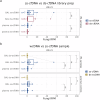NGS-based Aspergillus detection in plasma and lung lavage of children with invasive pulmonary aspergillosis
- PMID: 40097415
- PMCID: PMC11914610
- DOI: 10.1038/s41525-025-00482-8
NGS-based Aspergillus detection in plasma and lung lavage of children with invasive pulmonary aspergillosis
Abstract
In immunocompromised pediatric patients, diagnosing invasive pulmonary aspergillosis (IPA) poses a significant challenge. Next-Generation Sequencing (NGS) shows promise for detecting fungal DNA but lacks standardization. This study aims to advance towards clinical evaluation of liquid biopsy NGS for Aspergillus detection, through an evaluation of wet-lab procedures and computational analysis. Our findings support using both CHM13v2.0 and GRCh38.p14 in host-read mapping to reduce fungal false-positives. We demonstrate the sensitivity of our custom kraken2 database, cRE.21, in detecting Aspergillus species. Additionally, cell-free DNA sequencing shows superior performance to whole-cell DNA sequencing by recovering higher fractions of fungal DNA in lung fluid (bronchoalveolar lavage [BAL] fluid) and plasma samples from pediatric patients with probable IPA. In a proof-of-principle, A. fumigatus was identified in 5 out of 7 BAL fluid samples and 3 out of 5 plasma samples. This optimized workflow can advance fungal-NGS research and represents a step towards enhancing diagnostic certainty by enabling more sensitive and accurate species-level diagnosis of IPA in immunocompromised patients.
© 2025. The Author(s).
Conflict of interest statement
Competing interests: F.H. has received products/financial compensation from Pathonostics, OLM Diagnostics, Altona Diagnostics, EWC Diagnostics, CHROMagar, and IMMY in the context of product validation (and has published or will publish about the outcome of these studies). C.L. has received financial support from Pfizer for educational purposes. L.B. has regular interaction with pharmaceutical and other industrial partners. L.B. has not received personal fees or other personal benefits, but UMCU has received significant funding (>€100,000 per industrial partner) for investigator-initiated studies from AstraZeneca, Sanofi, Janssen, Pfizer, MSD, and MeMed Diagnostics, as well as major funding from the Bill and Melinda Gates Foundation and through public-private partnerships such as the IMI-funded RESCEU and PROMISE projects, involving partners GSK, Novavax, Janssen, AstraZeneca, Pfizer, and Sanofi, along with substantial funding from Julius Clinical for participation in clinical studies sponsored by AstraZeneca, Merck, and Pfizer, and minor funding (€1,000-25,000 per industrial partner) for consultation, DSMB membership, or invited lectures by Ablynx, Bavaria Nordic, GSK, Novavax, Pfizer, Moderna, AstraZeneca, MSD, Sanofi, and Janssen. L.B. is the founding chairman of the ReSViNET Foundation. J.d.R. is cofounder and CTO of Cyclomics, a genomics company. L.R., L.C., M.J., N.B., C.V., T.v.d.B. and T.W. declare no competing interests.
Figures






Similar articles
-
Development and optimization of quantitative PCR for the diagnosis of invasive aspergillosis with bronchoalveolar lavage fluid.BMC Infect Dis. 2008 May 29;8:73. doi: 10.1186/1471-2334-8-73. BMC Infect Dis. 2008. PMID: 18510764 Free PMC article.
-
Performance of galactomannan, beta-d-glucan, Aspergillus lateral-flow device, conventional culture, and PCR tests with bronchoalveolar lavage fluid for diagnosis of invasive pulmonary aspergillosis.J Clin Microbiol. 2014 Jun;52(6):2039-45. doi: 10.1128/JCM.00467-14. Epub 2014 Mar 26. J Clin Microbiol. 2014. PMID: 24671798 Free PMC article.
-
Diagnostic role of polymerase chain reaction in bronchoalveolar lavage fluid for invasive pulmonary aspergillosis in immunocompromised patients - A retrospective cohort study.Int J Infect Dis. 2019 Jun;83:20-25. doi: 10.1016/j.ijid.2019.03.025. Epub 2019 Mar 26. Int J Infect Dis. 2019. PMID: 30926540
-
Evaluation of Two Commercial Real-Time PCR Kits for Aspergillus DNA Detection in Bronchoalveolar Lavage Fluid in Patients with Invasive Pulmonary Aspergillosis.J Mol Diagn. 2018 May;20(3):298-306. doi: 10.1016/j.jmoldx.2017.12.005. Epub 2018 Feb 19. J Mol Diagn. 2018. PMID: 29471112 Free PMC article.
-
Positive Serum Beta-D-glucan by G Test and Aspergillus Fumigatus Sputum Culture Mimic Invasive Pulmonary Aspergillosis in a Pulmonary Nocardia Patient: a Case Report and Literature Review.Clin Lab. 2019 Jun 1;65(6). doi: 10.7754/Clin.Lab.2018.181105. Clin Lab. 2019. PMID: 31232022 Review.
References
-
- Loeffen, E. A. H. et al. Treatment-related mortality in children with cancer: prevalence and risk factors. Eur. J. Cancer121, 113–122 (2019). - PubMed
-
- Cesaro, S. et al. Retrospective study on the incidence and outcome of proven and probable invasive fungal infections in high-risk pediatric onco-hematological patients. Eur. J. Haematol.99, 240–248 (2017). - PubMed
-
- Bartlett, A. W. et al. Epidemiology of invasive fungal infections in immunocompromised children; an Australian national 10-year review. Pediatr. Blood Cancer66, e27564 (2019). - PubMed
Grants and funding
LinkOut - more resources
Full Text Sources
Research Materials
Miscellaneous

